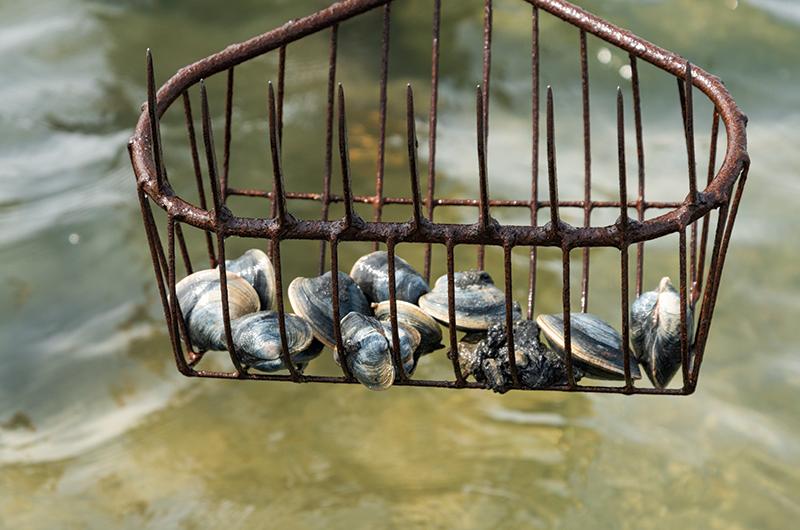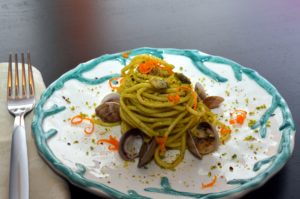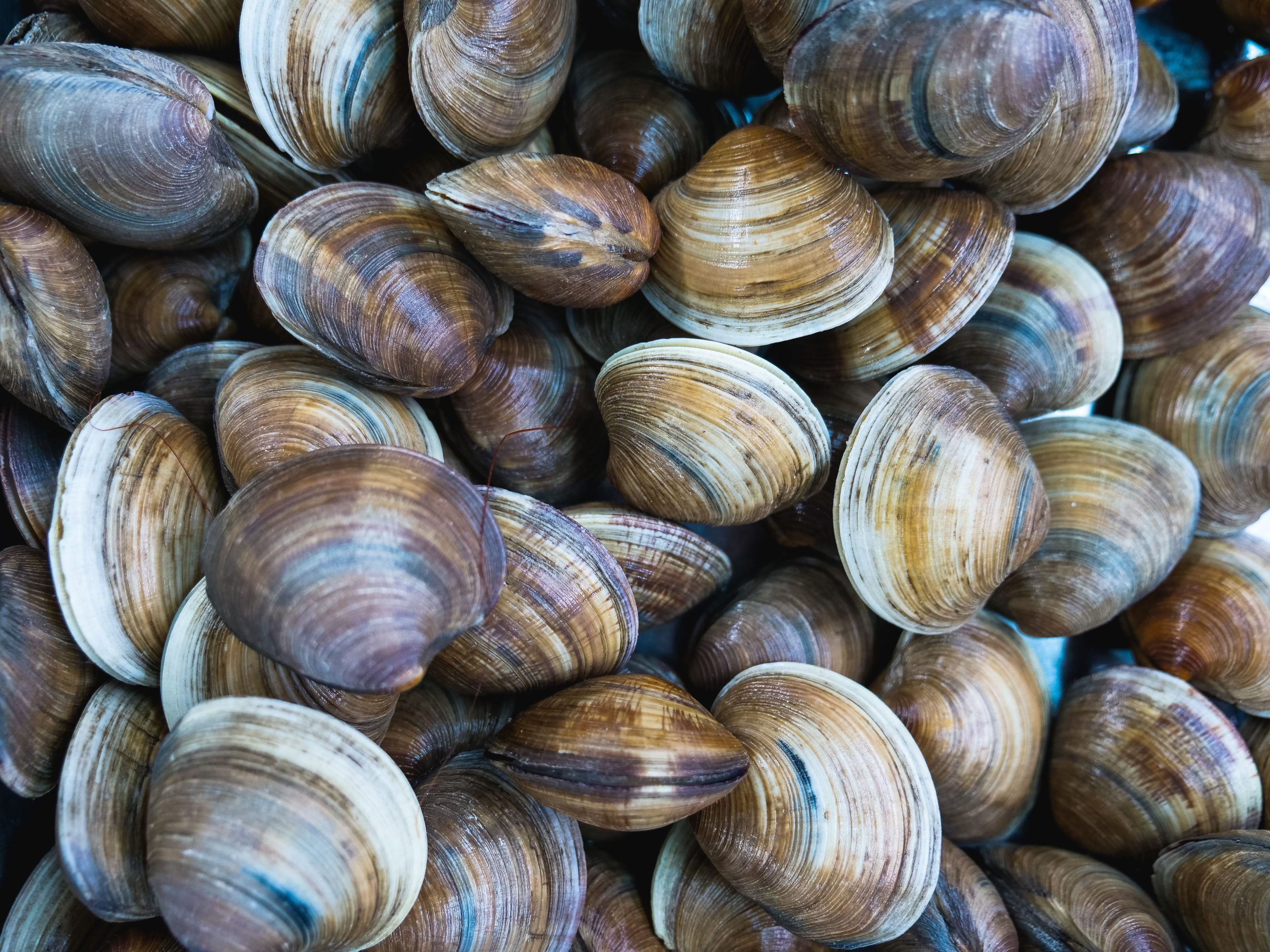Often, we see signs along the roadside, “Fresh Local Clams”. But exactly where do these “fresh local clams” come from? And how “fresh” can they possibly be? Exactly, what is the story behind those “fresh local clams”?
To begin with, our local clam is also referred to as “Quahog” (pronounced Kwo-hog) and is a species found along the east coast as far north as Maine. The Narragansett Tribe (who once populated modern day Rhode island), called these clams “Popquauhock”. The word, “Quahog” is said to come from that Narragansett word. Native Americans prepared clams in a variety of ways. The Algonquin People made a stew consisting of clams, corn and beans. Sometimes smoked fish or meat was added. This was the original recipe for clam chowder. On certain occasions, Native American women dug a hole and filled the bottom with wet seaweed. On top of this wet seaweed, the women laid piles of freshly caught clams. More wet seaweed was placed on top. Then dry wood was finally piled on to make a fire. This was the original “Clambake”.
Locally, Lenape Tribes summered in Southern Ocean County, where they harvested and processed clams for immediate consumption and for winter storage. Clams were smoked or dried on open fires and some were ground to a fine powder for use in winter dishes. Local Native Americans processed so many clams for so many years, early English settlers reported huge mounds of discarded clam shells towering over the marsh lands along the bay. Today, remains of these “shell mounds” can still be seen along Great Bay Boulevard.
Modern day Americans equate local clams with family gatherings, summer and the shore, but this was not always the case. The Pilgrim settlers fed clams and mussels to their hogs and referred to clams as, “the meanest of God’s blessings”. When America was an English colony and Americans identified themselves as “English”, clams were considered edible only if no other food was available.
But as Americans settled in the “New Land” and grew further away from European ties, this colonial attitude faded and a new “American” attitude took its place. Native American food was embraced by the “New” Americans. Clam chowder became a uniquely American dish. Clambakes became an American tradition.

From the 1800’s thru the 1900’s, local clams were harvested much the same way, with little change. Treading for clams was the Native American technique and was popular among many locals. Treading involves wading in shallow water and feeling for the clams with one’s feet. Various techniques of “raking” clams were used which included the scratch rake, the clam tong rake and Shinnecock rake. These rakes were equipped with baskets to hold the catch. The long handled Shinnecock rakes could harvest clams from deeper water.
During the early part of the 20th Century local clamming became a vital part of household incomes and Baymen competed for the best clamming spots. Americans always considered competition to be a healthy motivating factor… But in 1920, competition became so intense it sparked a war. The “West Creek and Parkertown Clam and Oyster War.”
Although no fatalities occurred during this conflict, several boats were vandalized, chickens stolen and a potato field was destroyed. There were incidents of arson reported, but exactly what was set on fire or who was to blame was never documented. Eventually, County Judge Howard Jeffrey became involved, resulting in the jailing of one resident and fines for other residents. Judge Jeffrey called events in Parkertown and West Creek, “a reign of terror” and he issued this harsh warning: “Anymore incidents and someone will suffer.” Fortunately, the Judge’s stern words were enough to insure peace between the two communities.
During the 1950s and 1960s, there were many Baymen who were “clammers” by trade. It was common to see flotillas of clam boats working the bay on a daily basis. Some people harvested clams after work or on weekends to supplement incomes. Local teens used the clamming industry for summer employment.
In those years, a late afternoon scene reproduced itself up and down the local coastline… Baymen and often their family members could be found by the water, sorting clams by size. Then they would count and bag the clams in burlap sacks. Daily catches sometimes amounted in the thousands of clams. After a long day of hard physical work on the bay, sorting and bagging clams was a lengthy process.
There was only the sound of the clams rattling against each other, while the people sorted and counted. They worked quietly so as not to disrupt and confuse the constant counting of clams. Talk could resume once the clams were counted. Then heavy sacks were loaded in the Bayman’s car trunk or pick-up bed, destined for fisheries, restaurants or clam dealers. The clams were usually delivered the day they were caught. Local clams were always fresh. And this was a way of life for many local people for many years.
Things appeared to continue unchanged during the final decades of the 20th century, but 200 years of harvesting clams began to take its toll. The natural clam stocks diminished and the daily catches became smaller. At the same time, Ocean County’s population increased and so did the demand for clams.
Lost income from smaller catches was mitigated by rising prices. This helped support the local Baymen. But then the oil shortages tripled fuel expenses. Nonetheless, clams were in demand, prices were up and dealers competed for local clams.
In the early 1980’s, one enterprising young clam dealer purchased a large machine which automatically sorted clams by size. He used this machine to market his clams as “a consistently and correctly sorted product”, which was important to restaurants. This machine also attracted local clammers by eliminating the lengthy hand sorting process of their catch. The young clam dealer went on to become one of Southern New Jersey’s largest seafood suppliers.
As local Baymen struggled to continue their way of life, natural clam stocks continued to dwindle. Eventually, there were not enough clams to support the entire clamming fleet. Change was on the horizon. During the next two decades, many local Baymen retired or found other ways to make a living.
But the public’s demand for local clams continued and new methods were sought to supply that demand. Although it began as little more than a local curiosity, some local Baymen began to experiment with aquaculture… farming clams. The process is much like land based farming in that it involves 3 steps: a hatchery, a nursery and then the field grown process before marketing. Up and down the east coast, clammers began to experiment with clam aquaculture.
Today, Shellfish Farmers have leased special “farming rights” in different parts of our local waters. These areas are marked with buoys and wooden stakes and are designated to be harvested only by the Shellfish Farmer. There are hundreds of shellfish farms operating up and down the east coast. With each passing year, more is learned about shellfish aquaculture and applied to the process. The result is a consistently growing supply of fresh clams. And because our local clam farmers only harvest what has been ordered for that day, local clams could not be any fresher.
A few local Baymen continue to traverse local waters and harvest wild clams for the market. Those Baymen work the water for the money, but they do it for other reasons as well. And those reasons are reasons only a Bayman can understand.

Of course, local recreational boaters can find an ample supply of wild clams in sections of the waters not used for farming. Treading or scratch raking is the preferred method and with a little work, enough can be caught for a large supper of clams on the grill or steamed clams or a pot of clams in white sauce (with linguini). And let’s not forget, clam chowder.
Information Sources: . “The Story Behind the Dish” by Mark McWilliams.
“Developments in Aquaculture and Fishery Sciences” Vol. 31 by JL McHugh.
“The Indians of New Jersey” by M.R. Harrington.
“Closed Sea, A History of Barnegat Bay” by Kent Mountford.
“Tuckerton Beacon” Vol XXxXIll, No. 30, February 24, 1921. —
